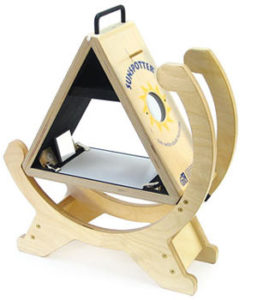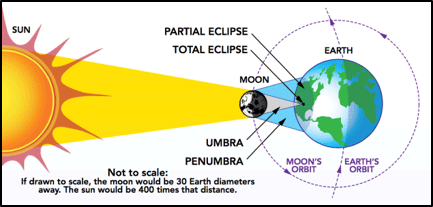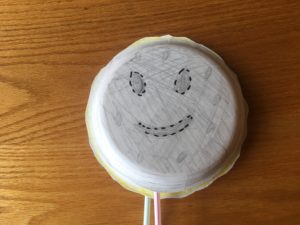 by Priscilla Robinson
by Priscilla Robinson
Science teachers aren’t the only ones energized about the eclipse of the Sun. People everywhere are anticipated to take time on Monday to view this cosmic phenomenon. All of North America will be in its path, with a huge swath of the United States witnessing a total solar eclipse. From Salem, Oregon to Charleston, South Carolina, twelve states are in the path of totality. So whether you are a teacher just back to school or a parent trying to make some final summer memories, check it out. It’s a once in a lifetime opportunity for you and the kids.
An excellent resource to plan your viewing is on a special NASA website. Dive into the site for lots of great science and viewing information. If it’s cloudy in your viewing area, you will still experience the darkening during the eclipse, just not the viewing of the phases. The NASA website will be streaming live from a variety of locations, so you can still be part of the day’s excitement.

This image shows the Aug. 1, 2008, solar eclipse at the point of totality, when the moon completely blocks out the body of the sun, revealing the normally hidden, halo-like corona. Image Credit: The Exploratorium
Quick and Easy Plan for an Eclipse Viewing Party
Focus on Eye Safety
 The safest way to view the eclipse is through a solar filter such as Solar Eclipse Glasses that meets the requirement for ISO 12312-2:2015. The code should be clearly displayed on the glasses. The glasses need to be in pristine condition—no scratches or bends. The paper glasses are rather flimsy so it’s best to use bobby pins, hair clips or even some tape to secure the glasses to your head.
The safest way to view the eclipse is through a solar filter such as Solar Eclipse Glasses that meets the requirement for ISO 12312-2:2015. The code should be clearly displayed on the glasses. The glasses need to be in pristine condition—no scratches or bends. The paper glasses are rather flimsy so it’s best to use bobby pins, hair clips or even some tape to secure the glasses to your head.
NASA has a wonderful link to instructions for creating your own 2D/3D pinhole projector in the shape of the United States or any state you choose. You can use a 3D printer or just create your projector on regular card stock. Instructions here.
Be sure to discuss the importance of wearing the glasses with your entire viewing party—children and adults alike! Remember to turn away from the Sun before you remove your glasses.
Another excellent (and completely safe) way to view an eclipse—or the Sun at any time of year—is with the Sunspotter Solar Telescope. The Sunspotter is a Folded-Keplerian telescope that safely projects an image of the sun where sunspots are clearly visible. You can take it with you wherever you plan to be on August 21st.
Keep Location Safety in Mind
Be sure to plan where you will be viewing the eclipse. Check ahead that the Sun is not obstructed by trees or buildings. Find a spot well away from traffic or other hazards.
Know the Perfect Time & Location
Access the interactive US map on the NASA website. Look for your state’s specific information so you can pinpoint the optimum viewing window. If you plan to travel to the swath of totality, be sure to give yourself extra time and call ahead for reservations. Here in Oregon, it’s anticipated that over one million people will be traveling from out of state.
Understand the Science
During the eclipse, the Moon will pass in front of the Sun. The two spheres are the perfect size and the perfect distance from each other and from the Earth to put on an exciting show that will last for hours from start to finish. Totality for this eclipse in the US will last for only a few minutes, so don’t be late! How much of the Sun is blocked out will depend on where you are. The total eclipse presents a rare opportunity to observe the corona and chromosphere, the two outermost layers of the Sun’s atmosphere. There’s lots more information on the NASA website.

Total Solar Eclipse showing umbral and penumbral lunar shadows. Image Courtesy NASA Astronomy Picture of the Day.
Fun Ideas for your Solar Eclipse Party
As a science educator, it has been fun for me to create an environment that is engaging, educational and FUN. Here are some traditional and new ideas to use at your Solar Eclipse gathering.
Pinhole Projector
Materials: Two dessert plates and a push pin
1) Create a small hole in the center of the first plate. Do not look at the Sun through the hole!
2) Stand with the Sun behind you and use the plate with the hole in it to shade the second plate.
3) You will see an image of the Sun and the phases of the eclipse as the Sun’s light shines through the hole. Note: the eclipse image will be backwards and upside down.
Variation: Write your name or the date on the plate. Use the push pin to poke holes ¼ inch apart on the letters to project your name in lights.
Colander Projector
Materials: kitchen colander
Place your kitchen colander on a light-colored sidewalk or on a table with the Sun shining on it. You will see multiple images of the Sun and the phases of the eclipse. Note: the eclipse image will be backwards and upside down.


Eclipse Puppet Show
Materials: two dessert plates, two drinking straws or craft sticks, tape, scissors, crayons or markers
1) One plate will represent the Sun and the other the Moon. For the Sun, color the back of the plate yellow. Trim away a very narrow scalloped edge.
2) For the Moon, color the back of the plate a light gray. Trim away a consistent ¼ or ½ inch band from the plate.

3) Attach a straw to the front of each plate.

4) You can role-play the phases of the eclipse as the Moon passes in front of the Sun.

5) Nest the Moon in the Sun and you can witness totality, with the Corona visible–the ghostly outer most layers of the Sun.

Observe birds and wildlife
During the total eclipse, animals that are active during the day may exhibit behaviors similar to evening—flocking to trees or act sleepy. For more on this phenomenon, consult this National Geographic article, “Surprising Ways Animals React to Solar Eclipses.”
For even more information about the Sun and how eclipses work, check out our “The Sun Is Pretty Hot Stuff!” blog!

